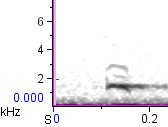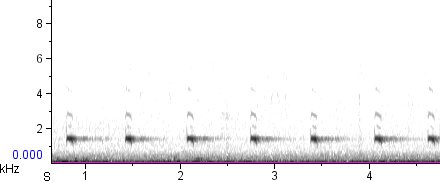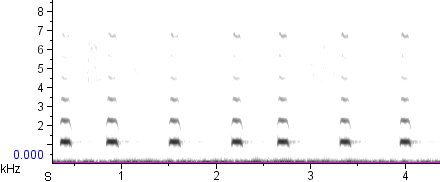Mountain Quail after all?
Don Roberson of Creagrus fame sent me an interesting and provocative email in response to the old pygmy-owl vs. chipmunk thread (1 2). With his permission, I’m reproducing it here for discussion:
A possible word of caution regarding analysis of chipmunk calls as discussed at http://earbirding.com/blog/archives/454:
I don’t necessarily disagree with your conclusions, but there are caveats to be considered. You may have already considered them, but on the off chance you have not, here they are.
1. You rely heavily on Brand (1976) for your starting point, and he studied primarily “Townsend’s Chipmunk” as stated. However, this was prior to the acceptance of the split of “Townsend’s” into four species, as proposed by Sutton & Nadler (1974) and Sutton (1987) [citations below]. Now, the 4-way split is universally accepted.
One of the major reasons for the split was the differences in vocalization between the four species. One of the two papers, probably the 1987 one, goes heavily into differences in calls. It has been a while since I’ve read them, and I don’t recall whether he went into “chips” versus “chuks” but a full background in the vocal differences between the for “Townsend’s” types is important before drawing generalizations from Brand’s 1976 paper. I don’t know how many species of chipmunk Brand reviewed, but there are 25 species in North America.
For more on chipmunk i.d., with some discussion of calls, see my 3-page web set on chipmunk i.d. that starts at
http://creagrus.home.montereybay.com/chipmunks.html
The Townsend’s four-way split and i.d./calls is on page 2 of the set;2. The call you have posted as probable Merriam’s Chipmunk “chuk” is a very commonly heard vocalization at Chews Ridge. I live in Monterey County and probably know the spot better than any other birder. I have never seen a chipmunk giving the call, although Merriam’s is common there. In fact I have puzzled over what does give the call. I have cautioned many times about claims of pygmy-owl there because of this note. However, I have generally attributed the note to Mt. Quail. In doing Breeding Bird Atlasing there and other similar habitats in the Santa Lucia Mts., there have been circumstances when a Mt. Quail was seen not long after and close to the source of the call.
If it is Merriam’s Chipmunk, that is very interesting, because it can be given in a steady and prolonged series that I haven’t attributed to chipmunks. [On the other hand, ground-squirrels do give a series of steady, prolonged, evenly-paced calls, so it is reasonable that a chipmunk would as well.]
Did any of your correspondents actually see a chipmunk doing these series of steady calls in California? I do think this could be the right answer to the mystery, but I would appreciate some analysis on why it is not a Mt. Quail.
Thanks, Don
Sutton, D. A. 1987. Analysis of Pacific coast Townsend’s Chipmunks (Rodentia: Sciuridae). Southwestern Naturalist 32: 371-376.
Sutton, D. A., and C. F. Nadler. 1974. Systematic revision of three Townsend’s Chipmunks (Eutamias townsendii). Southwestern Naturalist 19: 199-211.
In response to a couple of Don’s questions, I’ll say:
- Chipmunks definitely do give long steady series of call notes, both “chips” and “chucks”; the probable Least Chipmunk I recorded in Michigan vocalized at a nearly constant rate for over 12 minutes. I did visually identify that one as a chipmunk, although didn’t make a visual ID to species.
- Some of my correspondents have seen chipmunks making pygmy-owl-like sounds in California, although it’s apparently more common for the source of the sound to be unseen.
- I have tracked down the two sources Don cited; if you want PDF copies, email me. The 1987 paper mentions vocal distinctions only briefly, citing a personal communication from William Gannon and publishing no spectrograms. Another paper may go into the differences; I haven’t found it yet, but I haven’t searched long either. Gannon gave a paper at one point — Influence of proximity to rivers on chipmunk vocalization patterns. Gannon, William L. Special Publication the Museum of Southwestern Biology. 1997 24 March; 3:273-285 — but I haven’t had a chance to track it down yet.
I think we may have a lot to learn about chipmunk vocalizations! Comments?



